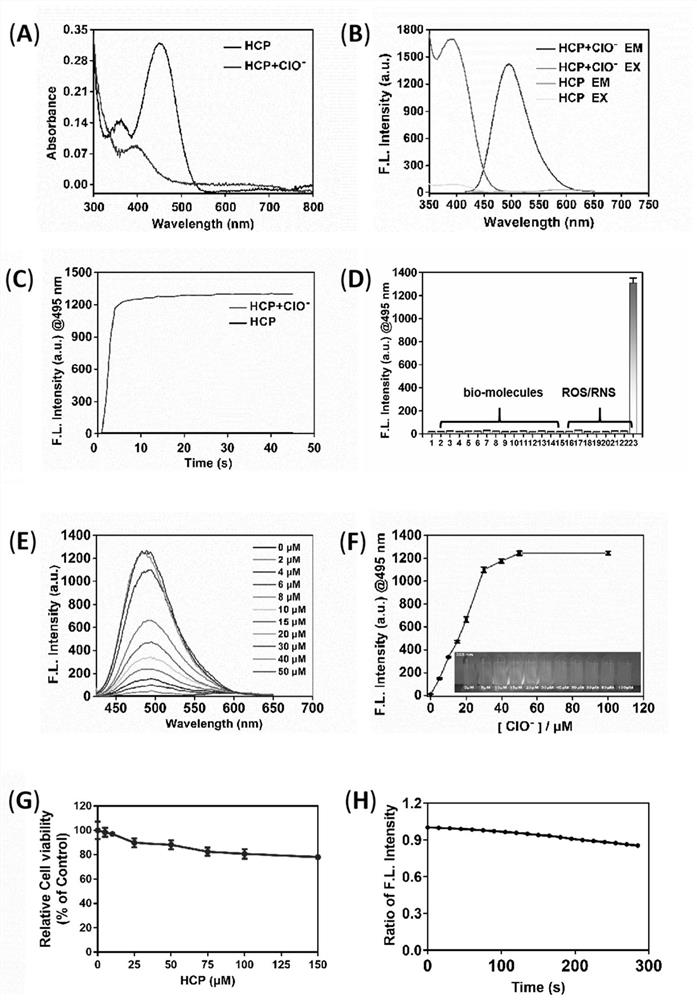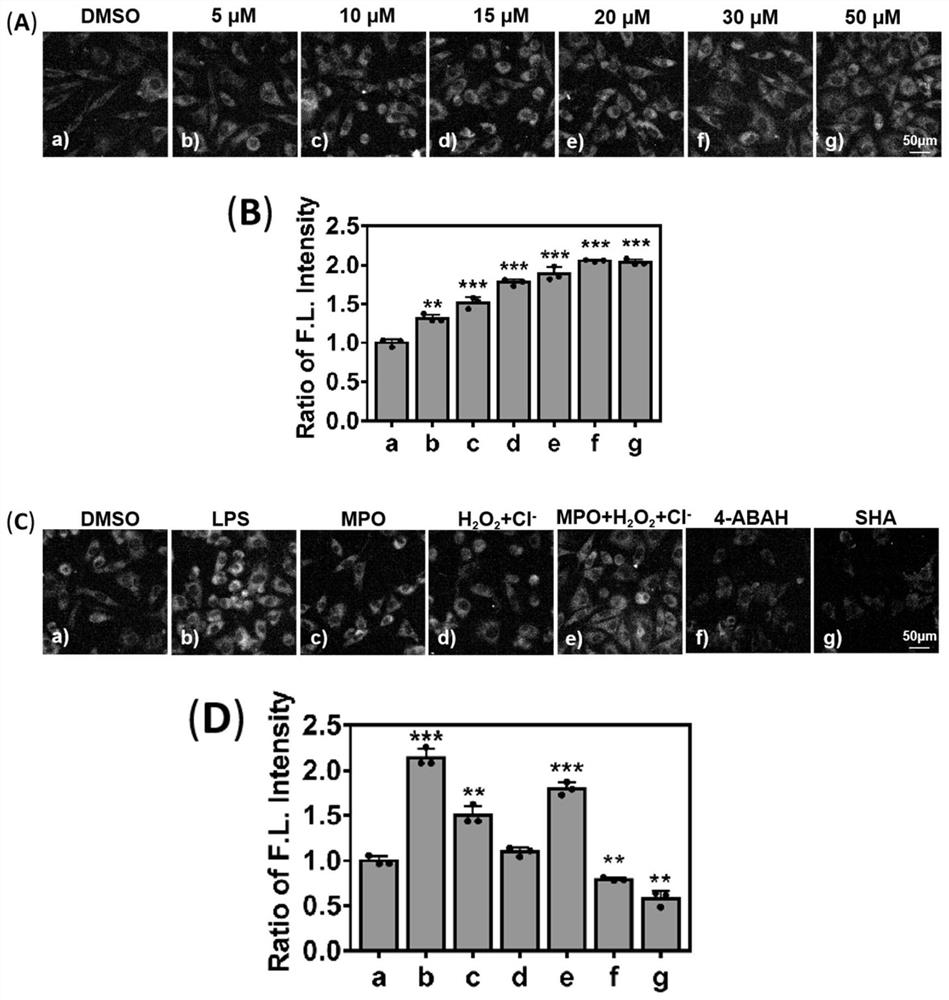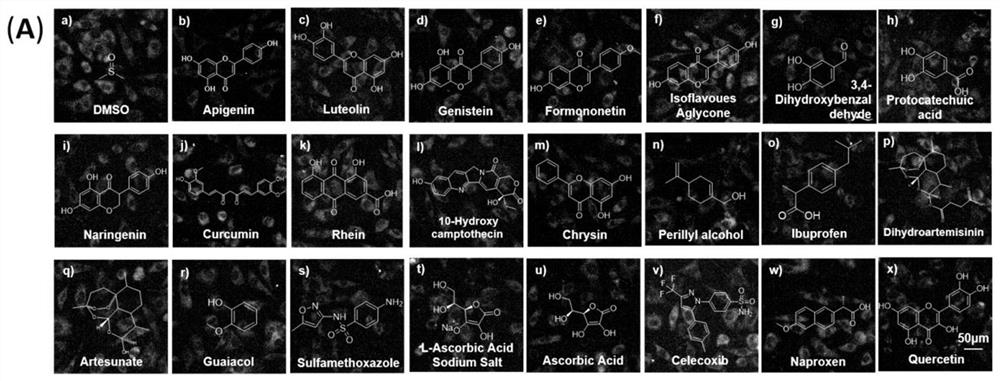A kind of hypochlorous acid two-photon fluorescent probe hcp and its preparation method and application
A two-photon fluorescence, hypochlorous acid technology, applied in the field of biochemistry, can solve the problem of no fluorescent probe, and achieve the effect of inhibiting cell apoptosis and reducing oxidative stress
- Summary
- Abstract
- Description
- Claims
- Application Information
AI Technical Summary
Problems solved by technology
Method used
Image
Examples
Embodiment 1
[0057] A kind of preparation method of the two-photon fluorescent probe HCP for hypochlorous acid, its preparation process is as follows:
[0058]
[0059] Compound 1: N,N-Dimethyl-p-phenylenediamine (5g, 36.7mmol, 1.0eq.) was dissolved in hydrochloric acid (6M, 66mL) and crotonaldehyde (6.0mL, 73.5mmol, 2eq.) was added, stirred at room temperature Afterwards, toluene (35 mL) was added to further reflux reaction overnight. The toluene was removed by cooling, and the aqueous layer was neutralized with saturated sodium hydroxide solution. Extracted with dichloromethane, washed with saturated sodium chloride solution, dried over anhydrous sodium sulfate, filtered and concentrated under reduced pressure. The crude product was purified by silica gel column chromatography (petroleum ether: ethyl acetate = 4:1 v / v) to obtain compound 2: 6-(dimethylamino)quinoline-2-methyl.
[0060] Selenium dioxide (2.8g, 25.1mmol, 1.3 equiv.) was heated and stirred in dioxane / water (v / v=10 / 1), ...
Embodiment 2
[0064] Synthesis and Preliminary Evaluation of HCP
[0065] In vitro spectral response of HCP to HOCl. First detect the spectral properties of HCP in phosphate buffered saline (PBS) (10mM, pH 7.4, 5% DMSO), HCP (quantum yield Φ, 0.025) itself shows a maximum absorption peak at 451nm and a fluorescence peak at 581nm . To test the response of HCPs to HOCl, absorption and fluorescence spectroscopy were performed under physiological conditions. After adding 50μM HOCl, the absorption and fluorescence peaks of 10μM HCP were significantly reduced, while the characteristic blue-shifted absorption and fluorescence emission peaks appeared at 396nm and 495nm, respectively. ( figure 1 Middle A and B) Time-dependent fluorescence studies show that the enhancement of fluorescence intensity is within 5 seconds, and the reaction speed is very fast ( figure 1 Middle C), the fluorescence intensity is enhanced by 138 times after reacting with HOCl. High-performance liquid chromatography-mass...
Embodiment 3
[0067] HCP selectivity
[0068] The specificity of HCPs was investigated by analyzing the fluorescence response upon addition of various analytes. Such as figure 1 As shown in middle D, the selectivity of HCP for HOCl is superior to that of other biologically relevant molecules, such as other competing reactive oxygen or nitrogen species (ROS / RNS) ( OH, O 2 -, 1 o 2 , H 2 o 2 , OBr - , TBHP, HOCl, NO, NO 2 - , NO 3 - ), biothiols (H 2 S, GSH, Cys) and metal ions (Cu 2+ , Fe 3+ and Zn 2+ ). Only HOCl can promote a significant enhancement of 10 μM HCP emission at 495 nm in PBS solution at pH 7.4 containing 5% DMSO; HCP fluorescence was not observed even at higher concentrations (10 equiv) in the presence of other interfering substances Significant changes in the spectrum. In enhancing the fluorescence intensity at 495 nm, HCP is >40-fold and >80-fold more selective for HOCl than other species. It should be noted that hypobromous acid (HBrO, pKa 8.8) can be produ...
PUM
 Login to View More
Login to View More Abstract
Description
Claims
Application Information
 Login to View More
Login to View More - R&D
- Intellectual Property
- Life Sciences
- Materials
- Tech Scout
- Unparalleled Data Quality
- Higher Quality Content
- 60% Fewer Hallucinations
Browse by: Latest US Patents, China's latest patents, Technical Efficacy Thesaurus, Application Domain, Technology Topic, Popular Technical Reports.
© 2025 PatSnap. All rights reserved.Legal|Privacy policy|Modern Slavery Act Transparency Statement|Sitemap|About US| Contact US: help@patsnap.com



